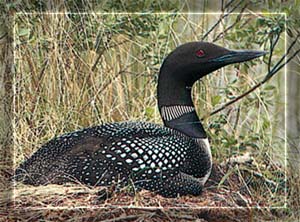|
|
|
Loons
![]()
The Loon's Call (300kb)

Also called "Diver" (Gavia), the loon is any one of four species of diving birds constituting the family Gaviidae (order Gaviiformes). Loons range in length from 60 to 90 cm (2 to 3 feet). Characteristics include a strong, tapered bill; small pointed wings; webs between the front three toes; and legs placed far back on the body, making walking awkward. Loons have thick plumage, mainly black or gray above and white below. During the breeding season the dorsal plumage is patterned with white markings, except in the red-throated loon (species Gavia stellata), which, during the summer, is distinguished by a reddish brown throat patch. In winter the red-throated loon develops white speckling on the back, while the other species lose these markings.
The beautiful loon is one of the earth's oldest living bird species - 60 million years! The voice is distinctive, including guttural sounds and the eerie, wailing cries, and its name comes from a Norwegian word that means "wild, sad cry." Almost wholly aquatic, loons can swim long distances underwater and can dive from the surface to a depth of 60 m (200 feet). They are generally found singly or in pairs, but some species, especially the Arctic loon, or black-throated diver (G. arctica), winter or migrate in flocks.
They feed mainly on fishes, crustaceans, and insects. The nest is usually a heap of vegetation at the water's edge, in which two (or rarely three) olive-brown, spotted eggs are laid. The parents share the task of incubation. The chicks hatch in about 30 days and, as soon as their down is dry, enter the water with the parents. Although loons are strong fliers, all but the small red-throated loon need a broad expanse of water for takeoff. Thus, except for G. stellata, they are limited to large lakes. The common loon, or great northern diver (G. immer), is the most abundant loon in North America; its counterpart across Eurasia is the similar white- (or yellow-) billed diver (G. adamsii). The red-throated and arctic loons are virtually circumpolar in distribution, the latter being most abundant on the Pacific coast of North America.
There are designated loon sanctuaries here on the lake, so that these sea birds are able to nest. The fledglings leave here in the Fall and head out to sea for 3 years before returning. The loon is also the State Bird of Minnesota.
Loon Medicine
Poor Boy raises two loons as if they were his own children, and is befriended by the son of a chief. This chief's son, although in love with the daughter of another chief, decides not wed and asks Poor Boy to consummate with her. The daughter is told the son will not marry her unless she consort with Poor Boy. She, of course, refuses. Through various guiles and endeavors, the deceptive plot continues until Poor Boy reveals the knavery and weds the daughter. One day after their marriage, Poor Boy follows the loons and learns the healing power. Later, while Poor Boy is away, his wife takes on a lover who mistreats the loons. The loons become ill and tell Poor Boy his wife has been unfaithful. Poor Boy banishes his wife after the loons die. He skins the loons keeping them for their healing medicine and then dies of a broken heart. [Plains, Pawnee] from Encyclopedia Mythica
![]()
Foxes
|| Loons
|| Manatee
Moose || Raven
||
Turkey || Wolves
Main SiteGuide
Avian Critter || Canine Critter
|| Human Critters
Beanie
Critters || Wild Critters
Interests & Hobbies & Links, Oh My!
![]()
background/hr by me: Papagei Studios